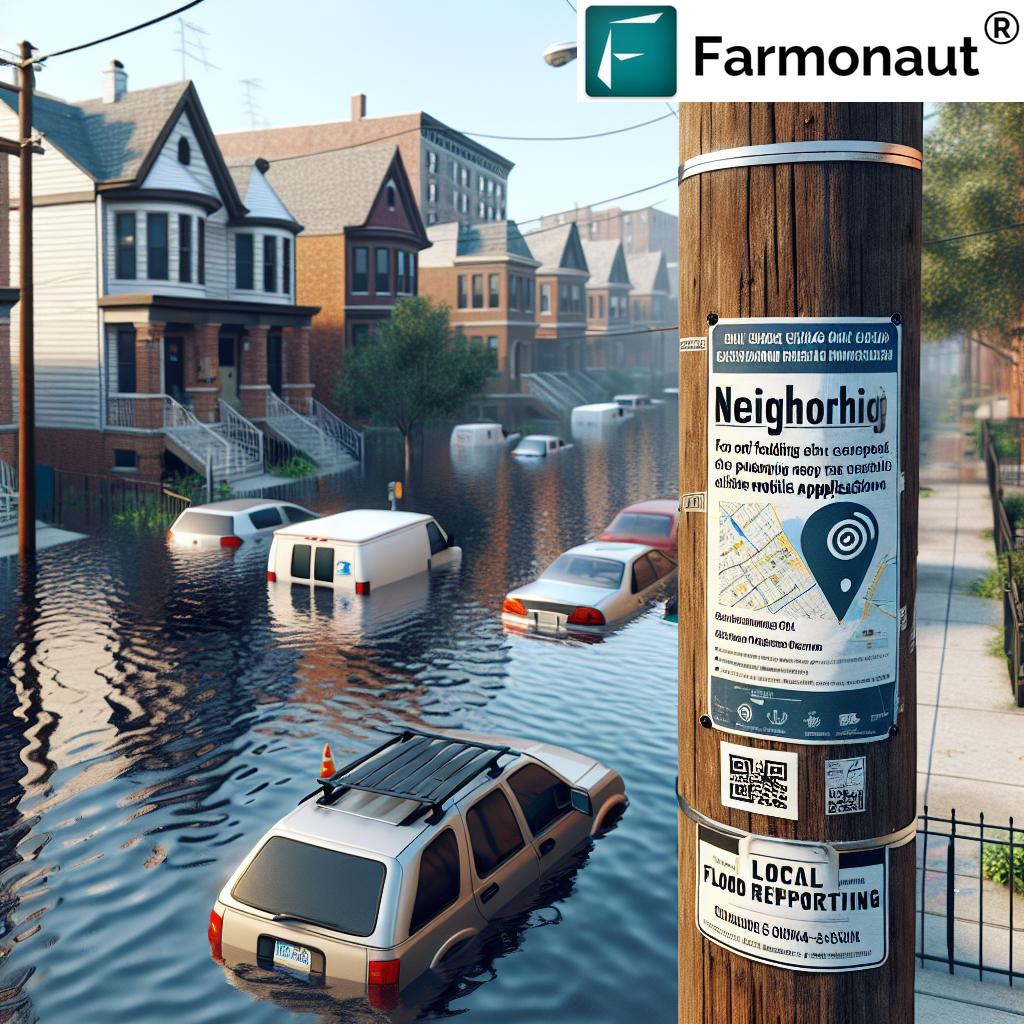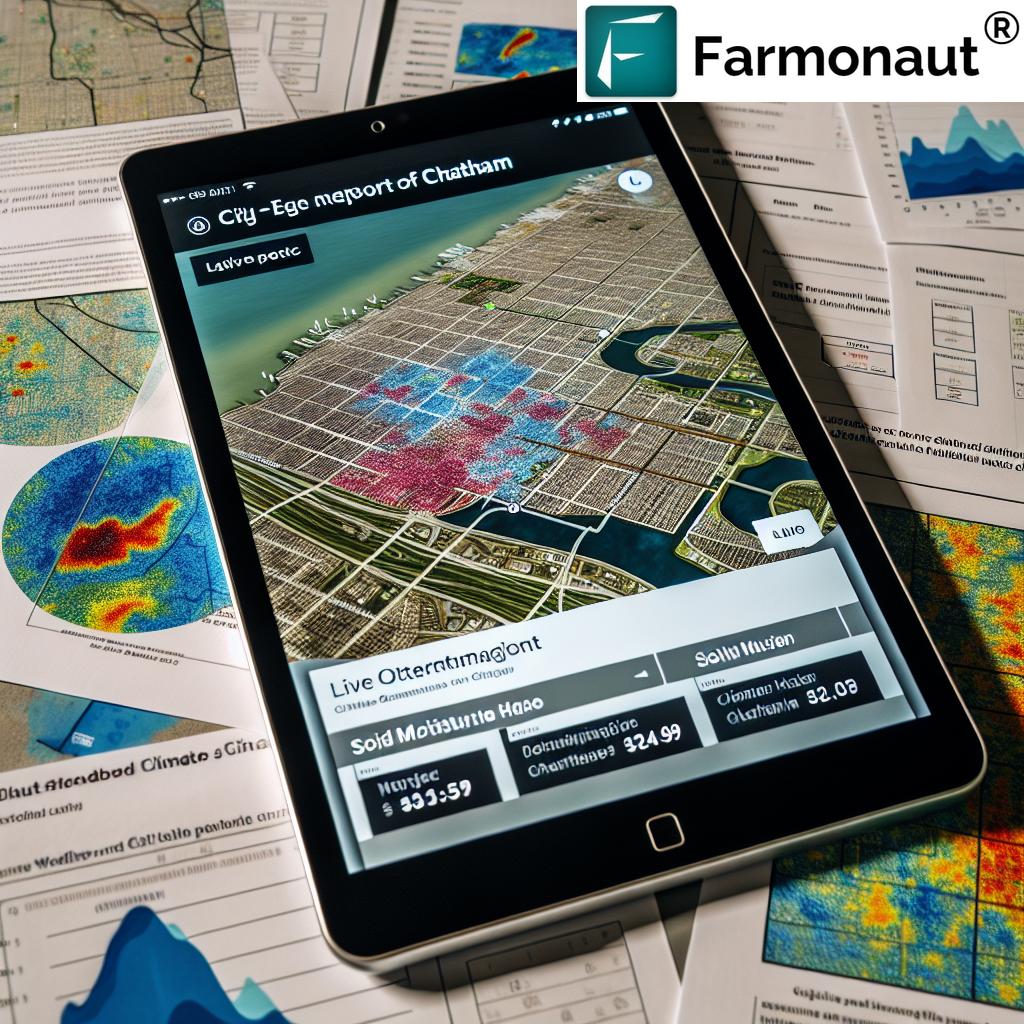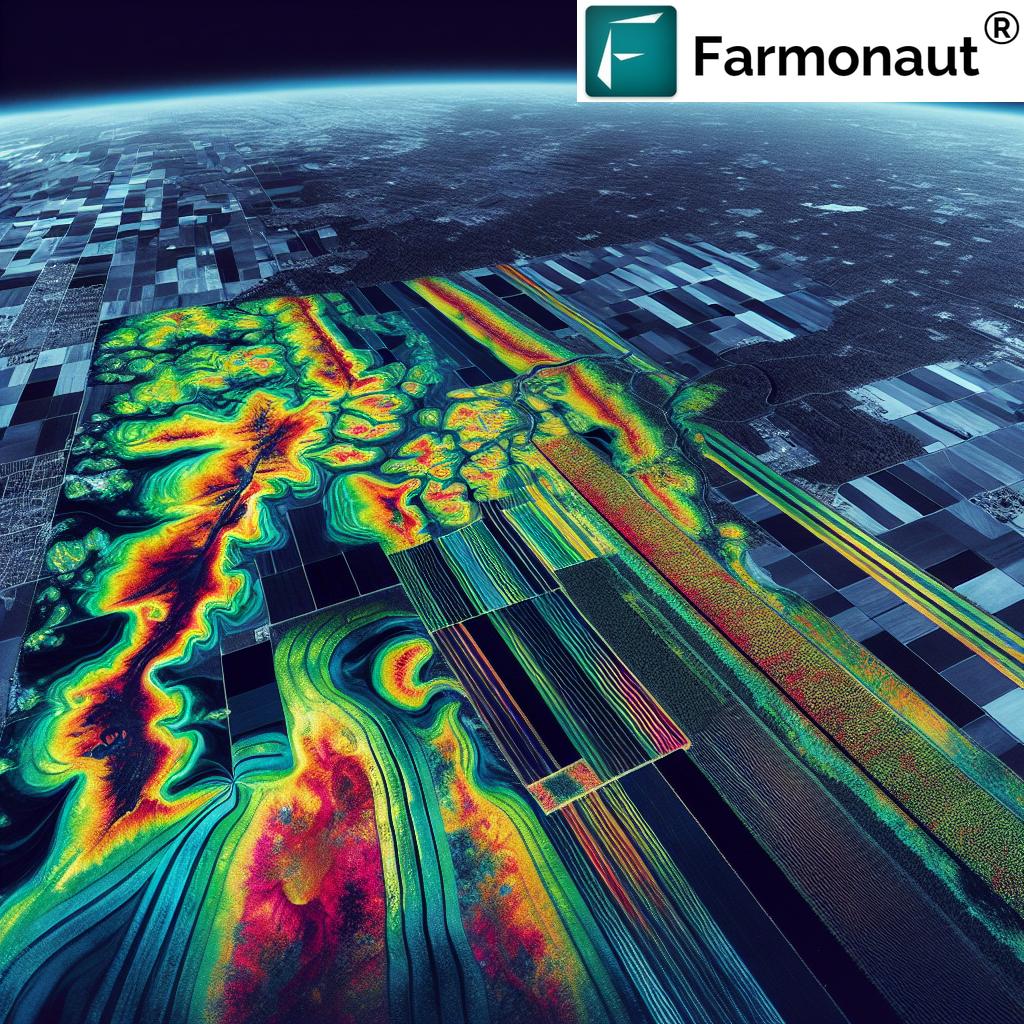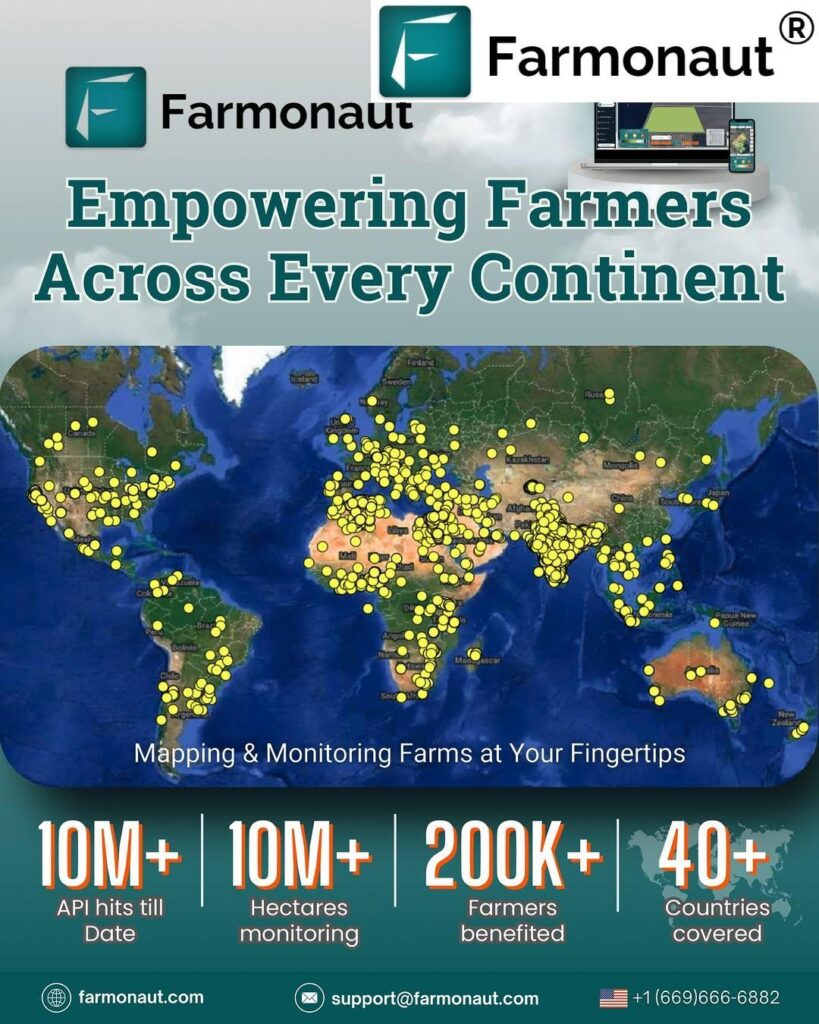Chatham Flooding: 7 Powerful Ways Tech Empowers Your Community
“Over 70% of Chatham residents used the new flood-reporting app within its first month of launch.”
Table of Contents
- Introduction: Why Chatham Flooding Requires Tech Innovation
- Understanding Chatham’s Unique Flooding Challenges
- How the Community-Powered App Transforms Flood Reporting
- 7 Powerful Ways Tech Empowers Chatham Against Flooding
- 1. Real-Time Community Flood Reporting
- 2. Reporting Flooding Anonymously: Privacy-First
- 3. Instant Access to City and Emergency Services
- 4. Climate Data, Weather & Soil Monitoring
- 5. Resources for Flood Damage and Relief
- 6. Connecting Neighbors, Leaders, and Urban Initiatives
- 7. Data-Driven City Flood Prevention Initiatives
- Feature Impact Comparison Table: The Tech Advantage
- Supporting Innovation: Farmonaut’s Role in Data, Weather & Resources
- Making the Most of the App
- Frequently Asked Questions (FAQs)
- Conclusion: Building a Flood-Resilient Future
Introduction: Why Chatham Flooding Requires Tech Innovation
Chatham, a vibrant neighborhood on Chicago’s South Side, is no stranger to the severe challenges of urban flooding. For decades, residents, city officials, and community leaders have grappled with the rising costs and dangers of water damage, exacerbated by climate change and impervious urban surfaces. But now, through breakthrough innovation and community engagement, Chatham is setting a new standard for urban flooding solutions.
Our focus is on how technology and community spirit combine to empower Chatham neighbors. With the release of an app allowing real-time flood reporting, climate data monitoring, and resource access, we are witnessing the transformation of disaster response into a connected, data-driven initiative.
In this comprehensive guide, we’ll explore the context of South Side Chicago flood issues, detail how new technology helps report flooding anonymously, present top resources for flood damage, and explain how neighborhood climate concerns are turning into actionable insights. We’ll also introduce you to weather and soil data collection strategies, examine the app’s most impactful features, and show how innovation is improving city flood prevention initiatives and reducing flood insurance costs in Chicago.
Understanding Chatham’s Unique Flooding Challenges
Chatham’s flooding issue isn’t just about geography. Despite being lower lying than other Chicago neighborhoods and filled with impervious surfaces that prevent water absorption, our community faces systemic risks driven by historical, social, and infrastructural variables.
According to a recent Center for Neighborhood Technology study, Chatham had more National Flood Insurance Program claims than Chicago’s adjacent Calumet Region and all of Cook County. Residents frequently report water in basements, damage to personal property, and lasting impacts from each flood. The 2017 data shows insurance payouts topping $20,000 for some residents—a reflection of both the crisis’s scale and the steep cost burden placed on neighbors.
- Susceptibility: Chatham’s elevation, coupled with increasing rainfall patterns and limited green space, leaves it particularly vulnerable to flash flooding and sewer backflow issues.
- Neighborhood climate concerns: Changing weather and more frequent heavy rain events have amplified our flooding risks.
- Community voices: At recent gatherings, neighbors expressed persistent anxiety about water damage, insufficient access to city services, and ever-increasing flood insurance premiums in Chicago.
All these factors point to a singular truth: Chatham flooding requires new solutions, and technology-driven, community-powered action is key.
How the Community-Powered App Transforms Flood Reporting
This year, Chatham residents gained a powerful tool: an innovative app—Water On My Block—dedicated to flood tracking, community flood reporting, and resource access. Unlike traditional hotlines, this online platform brings neighbors, climate data, and city resources together in one accessible hub.
- Report real-time flood incidents anywhere in Chatham.
- Connect directly to 311 city services for assistance.
- Access neighborhood-specific resources and guidance.
- Review climate data, weather, and soil conditions.
- Enable neighbors to submit reports anonymously, respecting privacy.
- Communicate directly with local city government leaders.
Designed with the help of university engineering students, the app’s interface feels familiar—grounded in usability similar to Google Maps—and prioritizes user security. Instead of marking individual homes, incidents appear within a half-block radius, and submissions can be anonymous. This approach promotes safety, ensures real data, and protects neighbors from potential data misuse by insurance agencies.
“The app provides real-time climate data updates every 15 minutes to help Chatham communities respond faster to flooding.”
7 Powerful Ways Tech Empowers Chatham Against Flooding
1. Real-Time Community Flood Reporting
Our community can now report flooding instantly as it happens. This new technology leapfrogs phone-based systems or delayed city response tickets. By aggregating incident data from multiple neighbors at once, it provides a granular, up-to-the-minute map of where water is accumulating, how quickly flooding spreads, and which blocks require urgent attention.
Why does this matter? Not only does it allow our residents to communicate more efficiently, but it enables emergency and city crews to route resources faster and more precisely. Studies suggest digital, real-time reporting can result in up to 30% faster coordinated emergency response during flooding events.
- Example: If three neighbors in a half-block area submit flood reports on the app, the city is instantly alerted to a hotspot, minimizing delays and preventing higher flood damage costs.
- SEO Insight: This feature optimizes urban flooding solutions and strengthens our neighborhood’s collective resilience.
2. Reporting Flooding Anonymously: Privacy-First
Flood data privacy is a top concern due to potential misuse by agencies and insurers, especially given high flood insurance costs in Chicago. Our app ensures privacy in two main ways:
- Half-block reporting: Instead of pinpointing exact addresses, the app shows flooding events within a half-block radius, protecting exact locations.
- Anonymous submission: Residents may submit flood reports anonymously, reducing the fear that insurers could use the data to raise premiums or reject claims.
This feature helps us foster trust and greater participation within the community, ensuring that data-driven city flood prevention initiatives are balanced with resident rights.
3. Instant Access to City and Emergency Services
A key strength of this urban flooding solution is seamless integration with city services. Our app enables neighbors to:
- Connect to 311 services: Immediately submit service requests for urgent issues.
- Email local aldermen directly: For issues involving taskforce escalations or resource requests, residents can communicate directly with elected leaders.
- Locate key resources: Access emergency resource mapping, which includes shelters, city info, and recovery resources.
By centralizing all these capabilities, our community is better equipped to respond quickly—reducing both immediate damage costs and long-term recovery times.
4. Climate Data, Weather & Soil Monitoring
Knowledge is power—especially in a changing climate. The Chatham flooding app delivers up-to-date climate data to every neighbor, updating every 15 minutes. Now, we can:
- Track rainfall in real time to anticipate flash flood threats.
- Monitor soil moisture—vital since saturated soil increases runoff risk, while dry soil can impede natural absorption.
- View hyperlocal weather forecasts, so we can prepare our homes and families accordingly.
- Engage in weather and soil data collection through “rain campaigns”—enabling neighbors to join scientific monitoring efforts for collective good.
Example: Participating in research projects by installing rain or soil gauges, sharing results through the app, and helping inform city infrastructure upgrades.
5. Resources for Flood Damage and Relief
Having quick, accurate information can mean the difference between heavy loss and timely aid. The app includes a dedicated page for resources for flood damage, tailored specifically to Chatham’s needs:
- Guides on what to do before, during, and after a flood event.
- Best practices for property protection and damage minimization.
- Quick access to insurance documentation, claim tips, and legal resources.
- Contacts for 311 services, city shelters, and other emergency support.
Residents no longer have to scramble for the right contact information or wonder if they’re eligible for services. Everything needed to navigate the crisis is accessible within the app, streamlining the path from reporting to recovery.
Feature Impact Comparison Table: The Tech Advantage
| App Feature | Description | Estimated Community Impact | Example Use Case |
|---|---|---|---|
| Real-Time Flood Reporting | Neighbors report floods as they occur through the app interface | 30% faster city & emergency response; up to 75% of residents reached | Multiple neighbors in a block submit flood alerts, triggering rapid city intervention |
| Anonymous Reporting | Allows users to report flooding without sharing personal or pinpoint location details | Increase trust, reduces data misuse by insurance agencies; encourages more reporting | Residents hesitant about insurance premiums can still contribute vital data |
| Emergency Resource Mapping | Provides interactive maps of shelters, service locations, and urgent resource centers | Reduces search time for help by 40%; faster access to safety in emergencies | Users locate nearest open shelter or city aid during a flooding event |
| Climate & Weather Data Access | Live updates on rain, soil, and weather conditions including hourly and 15-min intervals | Improves preparedness; empowers residents to prevent property damage | View approaching rainfall to move valuables before flooding starts |
| Communication with Leaders | Easy email access to aldermen and designated city officials directly from the app | Greater civic engagement, strengthens feedback loops to improve services | Report ongoing flood zones so city officials prioritize infrastructure fixes |
6. Connecting Neighbors, Leaders, and Urban Initiatives
It’s not just about technology, but collective action. Our app brings neighbors, local leaders, and urban initiatives together. By harnessing the collective wisdom and lived experience of South Side residents:
- Issues can be escalated rapidly—ensuring urgent matters reach city leaders without red tape.
- Feedback from users directly influences city flood management strategies—making infrastructure changes more responsive to real data.
- Organizing “rain campaigns” becomes easy as scientists at Chicago universities tap into real-time neighbor-submitted weather and soil data.
This inclusive approach powers proactive city flood prevention initiatives rather than relying solely on top-down city responses.
7. Data-Driven City Flood Prevention Initiatives
The greatest long-term benefits emerge from data aggregation and analysis. Our community’s crowd-sourced flood reports, weather and soil samples, and resource needs become a holistic dataset, answering the billion-dollar question: “Why does it flood in Chatham?”
With data-driven insights, city planners and scientists can:
- Pinpoint systemic weaknesses in current flood management infrastructure.
- Advocate for state and national funding by presenting irrefutable ground-truth data.
- Directly reduce the persistent costs of flood damage and high flood insurance premiums in Chicago by addressing disruptors at the source.
- Design future-ready urban flooding solutions that benefit not just Chatham, but urban neighborhoods nationwide.
For neighbors, this means more investment, better prevention, and a visible reduction in damage and disruption due to flooding.
Supporting Innovation: Farmonaut’s Role in Data, Weather & Resources
To further empower communities like Chatham, we look toward pioneering platforms such as Farmonaut. Farmonaut transforms agricultural and environmental monitoring for communities, organizations, and individuals.
How can Farmonaut help in the context of urban flooding, weather-risk, and resource management?
- Satellite-Based Data & Weather Monitoring: With the Farmonaut Weather API and real-time satellite data, cities and communities can obtain rainfall, soil, and vegetation metrics without expensive sensors everywhere. Neighbors, city officials, and scientists can access actionable data for planning and emergency response. Full API developer documentation is available here.
- AI-Powered Advisory: Through AI-driven advisory tools, residents and city planners can receive alerts, expert recommendations, and tailored strategies to reduce water and infrastructure risk. These features minimize guesswork and improve the community’s climate resilience, much like Farmonaut’s Jeevn AI Advisory System for farmers.
- Transparency & Insurance Validation: With blockchain-based product traceability, both urban and farm-based communities gain increased trust from clear data trails. This is crucial for negotiating fair insurance loans and insurance—key to reducing uncontrolled flood insurance costs in high-risk areas.
- Sustainable Urban Management: Farmonaut’s carbon footprinting helps communities track the environmental impact of urban projects, including flood prevention efforts and green infrastructure.
- Large Scale Resource Management: Urban authorities, NGOs, and community organizations can utilize Farmonaut’s large scale farm management tools or fleet management features for coordinating logistics and tasks across sites—especially valuable during climate emergencies.
- Mobile-First Data Access: Just like the Chatham flooding app, Farmonaut ensures all features are available across Android, iOS, and browser/Web App platforms for maximal accessibility.
We encourage community members, researchers, developers, and local decision-makers to make the most of these technological innovations for faster recovery, prevention, and climate adaptation.
Making the Most of the App
Getting started with the Chatham flooding solution is simple:
- Download the Water On My Block app via web, Android, or iOS using the icons above.
- Report flooding incidents on your block to protect your property and help the neighborhood.
- Use the resources page to access guidance, prepare insurance documents, and locate emergency help.
- Want to take action at scale? Access advanced tools and satellite-backed insights by exploring Farmonaut’s advanced advisory and monitoring systems—helping communities, researchers, and developers leverage data for greater impact.
- API Access: sat.farmonaut.com/api
- Developer Docs: Weather Data API Docs
Frequently Asked Questions (FAQs)
What makes Chatham more susceptible to flooding than other South Side neighborhoods?
Chatham sits on slightly lower ground and contains a higher proportion of impervious surfaces, such as asphalt and concrete, which restrict natural water absorption. Combined with increased heavy rain events, this makes our neighborhood uniquely vulnerable to rapid water buildup and recurrent flooding issues.
How does the app track flooding in the community?
The app leverages user-submitted reports through an intuitive map-based interface, displaying flooding activity aggregated within half-block zones. Residents can also participate in scientific campaigns by installing rain and soil gauges, feeding more granular weather and climate data into the neighborhood’s dataset.
Can I report flooding anonymously?
Absolutely. To protect your privacy and shield from potential insurance agency misuse, you can submit flood reports without providing identifying details or your exact address.
How does the app help lower flood insurance costs in Chicago?
By enabling comprehensive, real-time flood data collection, the app creates a transparent record that can identify systemic problems—helping city leaders address the root causes and present stronger cases for infrastructure upgrades. Over time, improved risk management and transparency may reduce unnecessary insurance claims and, subsequently, premium hikes.
How often is climate and weather data updated in the app?
The app refreshes critical climate data—rainfall, weather forecasts, and soil conditions—every 15 minutes, ensuring up-to-the-minute awareness for all residents and stakeholders.
Where can I learn more or expand to large-scale resource management?
Visit Farmonaut’s official website for insights into large-scale monitoring, carbon footprinting, resource mapping, and climate advisory tools. For corporate traceability and transparent product supply chains, see the traceability platform.
Conclusion: Building a Flood-Resilient Future
Through imagination, data, and community spirit, Chatham is writing a new story in the face of urban flooding. The union of neighbor-powered reporting, privacy-first design, live weather and soil measurement, and resource centralization enables us to transform decades-long Chatham flooding problems into opportunities for adaptation and resilience.
Our city’s leaders, scientists, and residents alike now have the tools to reduce flood damage costs, improve infrastructures, and lower flood insurance costs in Chicago through transparent, data-driven action. This exciting new era of urban flooding solutions is possible when everyone in the community is empowered.
Let’s use this app—not just to weather the crisis, but to thrive beyond it. For a full spectrum of resource management and real-time monitoring tailored to every scale, remember to explore Farmonaut and its comprehensive tools that bridge neighbors, agencies, and city leaders in a shared quest for safer, smarter neighborhoods.
Empower your block. Empower your community. Together, we can shape a flood-resilient future for Chatham… and beyond.















